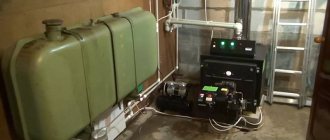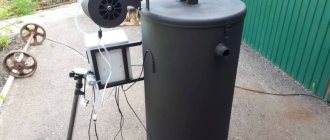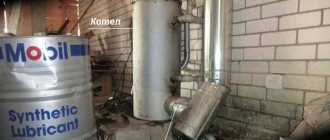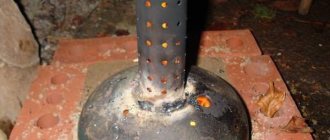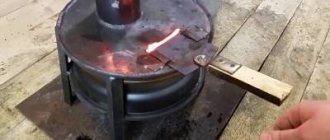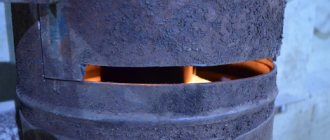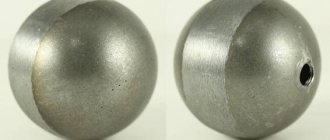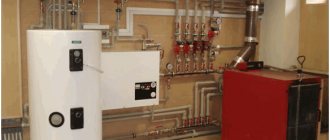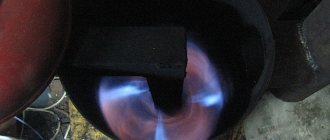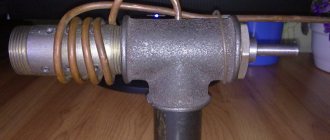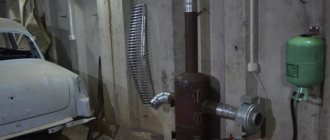SHARE ON SOCIAL NETWORKS
FacebookTwitterOkGoogle+PinterestVk
A profitable option for supplying heating to the room and providing hot water is a waste oil boiler. The device is characterized by a simple design, which allows you to make it yourself. This will help you save additional money. If this possibility is excluded, you can purchase a boiler for factory assembly testing. Currently, the product range is presented in a wide variety.
The boiler can use different types of waste oil, which is characterized by an abundance of various impurities
What is a waste oil boiler?
Today, heating equipment that operates during mining is very popular. This is due to a number of distinctive advantages of the device. First of all, this is the low cost of installation and the availability of fuel, which can be purchased for a nominal fee. Exhaust heating does not require the use of resources in the form of electricity and gas, which makes it economically profitable.
Despite its many advantages, the boiler during development also has its disadvantages
Important! Recycling waste products in full has a beneficial effect on the environment, eliminating the disposal of oil and its release onto the ground and into water bodies.
When the boiler is set up correctly, the waste oil is burned completely, which prevents the formation of toxic combustion products. The device consists of a minimum number of parts, which can be seen in boiler diagrams. This increases the reliability and durability of the structure. It does not take much time to heat up the boiler. Forced convection helps to quickly increase the temperature in the room.
Despite its many advantages, the boiler during testing also has disadvantages. When the device operates, moisture evaporates from the air and oxygen is burned, which negatively affects human health. Therefore, the boiler should be located in a non-residential area with a good ventilation system. Devices during mining quickly become dirty. This especially applies to the plasma bowl and chimney.
For such a boiler, different types of waste oil can be used, which is characterized by an abundance of various impurities. Therefore, to ensure a long period of operation of the device, a filter should be installed in the place where oil is supplied to the boiler, which must be changed as it becomes dirty.
The waste oil boiler should be located in a non-residential area with a good ventilation system
Waste oil boiler
I bought this boiler two years ago, started it up, set it up for a long time, and still smokes. A few days later, the gears in the oil pump broke, they turned out to be plastic, they restored it with their own hands, and converted it from the oil pump of a Ural motorcycle. Manufacturers are not very responsive, I would even tell them about our problems. Further, after the boiler had been running for about 10 hours, there was a power outage, and then the complete breakdown came... accordingly, after the shutdown, the automation and the fan that supplied air turned off, after a minute the boiler began to fire like a cannon, throwing out flames through the hole through which air was supplied from the fan, after the first shot, a flame of 1.5-2 meters passed 20 cm from my face and it continued shooting for about 10-15 minutes until the oil burned out and the boiler went out, fortunately there was nothing flammable nearby. Can you imagine my state at that moment, because I could have remained disabled and only by a lucky chance my face was not in front of the flame, this shot could even have killed me. I call with a complaint, they tell me, probably your hood is bad, they say the pipe is low, my pipe is 1.5 meters higher than the ridge of my building, the building is two-story, approximately the height of the pipe is 14 meters, the pipe is insulated with mineral wool and sheathed with galvanized sheet, that is, everything is as it should be. At that moment, the month of December, I was doing finishing work and desperately needed heat, I heated the first floor with a diesel gun, and the second floor with two gas guns, it took a lot of gas and diesel fuel and it was expensive. It was planned to use the oil recovery boiler in parallel with the gas boiler, and there would be some savings, so a car service center was planned on the first floor, and an administrative center on the second. Conducting gas is not an easy task, and it takes a long time, and I didn’t want to curtail the finishing work, so having calmed down a little from the shots, a week later I decided to start the boiler again, but now I realized that the battery must be connected in parallel to avoid the It was after a power outage. I lit the boiler, started it up, everything worked, but then a curious plumber, who came to check the batteries and the entire heating system that they had installed, decided to look into the firebox, opened it, and a flame began to come out from there, after which the flames were drawn into the boiler and suddenly splashed everything out through the firebox along with the oil and it all caught fire on the walls and on the floor, fortunately a bucket of water and a fire extinguisher were nearby and fortunately this burning oil did not splash out on that plumber. Here’s the story... I bought a boiler for 80,000 rubles, paid about 5,000 rubles for delivery to Tatarstan, now this boiler has been standing for two years as an exhibit and reminds me that I shouldn’t mess with uncertified homemade products and such charades as “Stavpech”. They didn’t give any instructions or really explain anything, and they didn’t even hint at warning about those unpleasant situations. I wanted to sue them and contact the police, but construction was in full swing, and I wanted to finish the construction quickly. And after all this, I began to move more actively on the gas. They gave me gas, I heat up without any problems, but I accidentally remembered about this boiler and decided to write to people who are thinking about buying, don’t make mistakes. Remember “Stavpech” is bad...
How does an exhaust boiler work?
Boilers for a private home using waste oil, as well as for a garage, workshop or industrial premises, have a simple design. They consist of two chamber compartments: an evaporation chamber and a combustion chamber. In the first compartment, the process of preparing used oil for combustion is carried out. In the second, it is burned. The principle of operation of the device is as follows.
From a container with used oil, the pump supplies the substance to the evaporation chamber, which is located in the lower part of the device. It maintains the required temperature, sufficient for heating and subsequent evaporation of the waste. Oil vapor rises to the upper zone of the housing, where the combustion chamber is located. It is additionally equipped with an air duct in the form of a pipe with holes. Using a fan, air is supplied through an air duct into the chamber, where it is mixed with oil vapor. The resulting mixture burns without a residue.
The heat exchanger distributes the resulting heat. The resulting combustion products enter the chimney. A mandatory process is preheating of the waste. Oil contains many impurities; under the influence of a certain temperature, the substance decomposes into simple carbons, which are subsequently burned. As a result, water vapor, nitrogen and gas are formed, which are harmless to the body.
Waste oil boilers have a simple design
Complete oxidation of carbohydrates is possible only at a temperature of 600 °C. If this value is not observed, the combustion process produces many toxic substances that are extremely dangerous to human health.
Types of waste oil boilers
There are three options for waste oil boilers: water heating, heating and domestic. The first option is an alternative to a modern boiler. Having a platform design, the device heats up the flat surface where the water tank is located. A small pump is installed at the outlet of the tank, which regulates the pressure in the system.
Important! It is very difficult to change the temperature of the water, so if necessary, it is recommended to dilute it with cold water.
For water heating boilers using waste oil, a water tank with a volume of no more than 140 liters is used. It heats up within 2 hours, which is several times faster than the operating speed of a modern electric boiler. An oil water heater can operate in two modes: fast and wick. The first option is used to heat completely cold water. The wick mode allows the water in the container to be heated. However, this will require a large amount of fuel resource.
There are three options for waste oil boilers: water heating, heating and domestic
Important! Oil water heaters during mining are installed in basements, since they are non-transportable.
Domestic boilers are considered the ideal solution for country houses. They have a built-in gas purification mechanism, which contributes to the operation of the device without smoke. Such devices are mobile structures, which will allow them to be moved to any place without affecting the functionality of the product. This multifunctional device allows you not only to heat the room, but also to heat food. The unit can be used outdoors or while traveling.
Automation for waste oil boilers can perform various functions. Here you can set up control over the heating of the coolant and the air temperature in the room. Such devices are installed on the floor. Their cost depends on the functional features of the device.
Due to the compact size of the hot water boiler, it is convenient to install it in the boiler room
Characteristics of a waste oil heating boiler
The waste oil heating boiler must be located in a non-residential area. As a rule, to heat a house it is installed in a special extension. Despite the fact that modern devices are equipped with an improved filtration unit, during operation they emit an unpleasant odor of machine oil.
The inside of the unit is equipped with a heating unit with a water tube and a hydraulic pump. The last element can operate from the electrical network or from the energy generated by the device itself. Using a hydraulic pump, the coolant circulates in the circuit in the form of ordinary water.
The principle of operation of the device is as follows. In the combustion chamber, oil vapors and air masses, which enter under the influence of a ventilated compressor, are oxidized. The fire level is regulated using a hose with a valve. The ventilation device is the only movable element, as a result of which it may fail.
Such boilers are characterized by high performance and the ability to maintain room temperature for a long time. The fuel container is located on the floor, and the air heater can be mounted on the wall or ceiling.
The internal part of the boiler block is equipped with a heating unit with a water tube and a hydraulic pump
The best known manufacturers and models: characteristics and prices
DanVex B-30
One of the best Finnish-made boilers for heating a private house. In addition to the 35.6 kW version, there are also other versions with a heating capacity of 60-220 kW. It is distinguished by high reliability, a well-thought-out system to simplify maintenance and cleaning (for example, an increased diameter of the firebox and smoke pipes, a vertical chimney, so that soot pours into the ash pan, a door that opens with the burner, so access to the combustion chamber is achieved by pressing the handle).
The boiler is also known for its compact size, functional automation with the ability to connect a GSM module and one of the highest efficiency for this type of boiler - 88%. Fuel consumption at maximum load is 3.3 l/h. The model has all the necessary protective functions and modes, the ability to connect a room thermostat and external temperature sensors.
The only known disadvantages are noisy operation, the absence of a fuel pump, heavy weight (157 kg) and an unreasonably high price. Country of origin: Finland.
NORTEC B70 (WB 40)
Model from a Russian manufacturer with a power of 40 kW. In terms of design and principle of operation, it does not differ from the above-mentioned Finnish analogue, it is equipped with the same heat exchanger made of heat-resistant steel, is less convenient to maintain, inferior in quality of materials and assembly, has larger dimensions and less functional controls.
However, it also has significant advantages in the form of a much lower cost, a full-fledged fuel unit (pump, filters, tank) included with the boiler, and the ability to operate on a large number of fuels (fuel oil, crude oil, heating oil).
EcoBoil-18
Vertical drip type model made in Russia with a power of 15 kW. The distinctive features of the model are its extremely low cost, compact size, reliability and the presence of an oil pump included. In addition to mining, it is capable of burning kerosene. The model is equipped with one of the best automatic control units in the drip oil boiler segment, but the automation is still inferior to standard models that spray fuel.
Also known disadvantages are the need for daily cleaning and domestic build quality. According to installation practice and owner reviews, in all cases the model has been working without problems for more than 7 years.
Cost : 36,800-39,900 rubles.
Furnace KDO-2
Another domestic drip-type model with a power of 28 kW. The boiler has the same design and operating principle as EcoBoil, but has a higher cost with less functional automation. The advantage is the removable pyrolysis bowl (in which the oil evaporates), this makes it easier to clean, and in case of burnout it can be easily replaced.
Cost : 44,500-50,000 rubles.
Subtleties of the process of creating a boiler for testing with your own hands
The most important component of the fuel combustion process is the preheating of the waste. This will allow the heavy substance to oxidize into light components. This result can be achieved by creating a thick-walled hot metal bowl into which the waste will be fed in drops.
When oil hits hot metal, the substance turns into vapor, which is discharged into the combustion chamber. There they must mix with air for better combustion, for which an air duct is used. It is equipped with an impeller, thanks to which the flow swirls, which contributes to a long stay of the oil-air mixture in the combustion chamber. Only in this case will the fuel burn completely.
To carry out the heating process of the evaporation bowl, a wick soaked in fuel should be placed in it. Next, a little diesel or gasoline is added and ignition is performed. When the metal heats up to the desired temperature, oil is supplied. This process is simple but very dangerous. Therefore, it is important to properly organize the flow of the substance into the nozzle for a waste oil boiler.
When oil hits hot metal, the substance turns into vapor, which is discharged into the combustion chamber
If the oil flows in a stream, the fuel will not have time to burn. As a result, toxic components are formed that are hazardous to human health. To achieve efficient combustion without smoke, a drip supply of fuel should be arranged. To do this, a hose is used, at one end of which a filter is installed. It is better to use a full filtration automotive oil element. Then a fragment of a medical dropper with a wheel-regulator is put on the hose. The element is fixed to the fitting. The oil from the dropper is directed into a funnel, which is connected to a pipe. It supplies fuel to the combustion bowl.
Making your own waste oil boiler with a water circuit
Based on studying the boiler drawing with your own hands using waste oil, the following necessary materials and tools are prepared:
- sheet of metal 4 mm thick for a tank or pipe with a diameter of 500 mm;
- pipes with a cross section of 200 mm;
- sheet metal 6 mm thick to create a cover;
- metal plates 3 mm thick;
- a piece of pipe for installing a chimney;
- oil supply pump;
- fan;
To make your own waste oil boiler with a water circuit, you need to know its components
- steel adapters;
- heat-resistant sealant;
- metal corner for supports;
- grinders with cutting wheel;
- drills;
- hammer;
- set of keys;
- welding machine with electrodes.
Helpful advice! To make it easier to create a homemade boiler for mining, you can use ready-made barrels for oxygen or propane.
The boiler body is conventionally divided into two parts. The heating radiator will be located at the bottom, and the water jacket will be at the top.
The process of making a boiler with your own hands using waste oil begins with the manufacture of an internal tank in the form of a container with a water jacket, a channel for oxygen supply and an oil pipe.
The boiler body is conventionally divided into two parts: radiator and water jacket
The dimensions of the tank elements are marked on a sheet of metal according to the drawing of the waste oil boiler. All parts are connected by welding. At the bottom of the housing there is a door for removing the bowl and igniting the oil. To speed up the process, the body can be made from a fragment of a pipe with a diameter of 500 mm and a length of 1 m.
Two round-shaped elements are cut out of metal plates, which will serve as the bottom and cover of the case. A round hole is made in the upper part, the size corresponding to the diameter of the perforated pipe into which it is inserted and welded. The body is covered with two plates by welding. Legs made of reinforcing bars are attached to its bottom.
The upper tank is made in a similar way. There is a hole in the lid for the chimney. To connect two containers, a burner tube with a diameter of 100 mm and a height of 35 cm is used. Holes with a diameter of 9 mm in the amount of 50 pieces are made in it. over the entire area of the product.
Related article:
Waste oil furnace: options for making the device yourself
Principle of operation. Device types. Factory assembled models. Making a furnace for testing with your own hands, design options.
By welding, all elements are connected to each other according to the drawing of the waste oil boiler. After installing the device on a flat concrete base, the chimney is installed. Its length is 3.5-4 m. To ensure good traction, the pipe must be inclined. The outer part must be vertical, and it is equipped with a special cover to protect it from snow and rain.
Oil options for waste oil boilers
Any type of waste oil can be used for these boilers. Not only machine ones are considered suitable, but also shock-absorbing, transformer, transmission, motor, hydraulic, rapeseed, vegetable and other types. The main requirement for fuel is the absence of water, flushing fluids, antifreeze and other undesirable components in its composition. Machine oil is the cheapest and most accessible option. It can be purchased in sufficient quantities at any service station.
Any type of waste oil can be used for boilers
A diesel fuel boiler is characterized by maximum efficiency. Oily substances can be added to it, which will act as a catalyst, which promotes a good combustion process. This could be fuel oil, kerosene, or barbecue lighter.
It is strictly forbidden to use alcohol, gasoline and other flammable substances as fuel for exhaust boilers.
Important! During combustion, fuel must not be added to containers. It is filled only after the fill has completely burned out and the tank has cooled down.
Advantages and disadvantages of oil boilers
The use of waste oil as fuel has clear advantages:
- Economical. Used oil is a recyclable material, the price of which is several times lower than that of other types of fuel. You can buy it at enterprises with a large number of cars, service stations and even in private garages.
- Autonomy. You do not depend on the gas pipeline, and when installing a battery, on electricity. This allows you to heat rooms located far from civilization.
- Simplicity of design. Reliability and durability of operation are ensured by the simplicity of the device and the predictability of the operating principle. With proper use and regular cleaning, the device has a long service life.
- Fast heating time. Already in the first minutes of work you will feel the temperature increase. This is especially noticeable when using air heating devices such as heat guns.
- Fire safety. Used oil itself is not flammable. This simplifies storage conditions and increases safety during use.
- You can install such equipment yourself; you will not need additional permits or the services of specialists, as is necessary if you install a gas boiler.
- If you suddenly run out of fuel, you can heat it with another type of liquid fuel. To do this, you will need to change the settings and in some cases replace the injector.
Liquid fuel boiler diagram
However, this heating method has its disadvantages:
- Regular cleaning required. Since initially unrefined fuel is used, it contains a number of unnecessary impurities that clog the device components. For a longer service life, it is important to clean it regularly.
- Search for fuel. Before purchasing this type of boiler, you need to look at what sources are available in your area. Compared to other fuels, used oil is more difficult to find.
- At low temperatures, oil freezes. This leads to the need for a special room for storing waste during the cold season.
- Initially, the cost of such equipment is high.
Review of Russian-made boilers using waste oil
Domestic waste oil boilers are manufactured mainly in Voronezh, where the manufacturer has all the necessary documents related to the production of products. There are also other small businesses. However, most of them do not have a state certificate for the manufacture of heating equipment. You should pay attention to this when purchasing a boiler.
Powerful boiler STV1 is characterized by high efficiency
The Teploterm GMB 30-50 kW double-circuit waste oil boiler is characterized by high quality workmanship in every detail. Thanks to a multifunctional microprocessor, it is equipped with an automatic control system. The device has many options that simplify the operation of the device, making it safe. Fuel consumption – 3-5.5 l/hour. The cost of the model is 95 thousand rubles.
A popular model is the Gecko 50 pyrolysis boiler. The device can operate not only on waste oil, but also on crude oil, diesel fuel, fuel oil of all brands, kerosene, fats and various types of oil. The boiler is undemanding to the quality and viscosity of the fuel. There is no need for pre-filtration and heating.
The design has small dimensions (46x66x95 cm) and weight 160 kg. The device is characterized by high efficiency, reliability of all elements and connecting units, ease of maintenance and repair. The maximum temperature in the device reaches 95 °C. The fuel consumption is 2-5 l/hour. Power consumption is 100 W. The price of a heating boiler using waste oil is 108 thousand rubles.
The KChM 5K combination boiler has a cast iron reliable body
The Stavfurnace boiler STV1 is characterized by high efficiency. The power of the device is 50 kW. The fuel mixture consumption is 1.5-4.5 l/hour. The body dimensions are 60x100x50 cm. The device is equipped with a reliable modulating burner for a waste oil boiler, which has a high emission rate. The device is equipped with a fuel filter, pump and water tank. Various types of oil, diesel fuel and kerosene can be used as fuel. The price of the boiler is 100 thousand rubles.
The combined apparatus KChM 5K has a cast iron body. It can operate not only on mining, but also on gas and solid fuel. The power of the device is 96 kW. The model is distinguished by high quality parts, safety in operation and durability. You can buy a boiler for 180 thousand rubles.
Expensive domestically produced waste oil boilers
The domestic automatic waste oil boiler Teplamos NT-100 is characterized by an expanded configuration. A double-circuit boiler can be used not only for heating, but also to provide hot water supply in the house. The model is characterized by high quality manufacturing of all components. External parts are powder coated to protect them from corrosion. The body has an internal thermal insulation coating in the form of high-density glass wool.
The Ecoboil-30/36 exhaust boiler can be used to heat a room up to 300 square meters. m
For ease of control, the device is equipped with a remote control, which allows it to operate in automatic mode. It consists of a switch, thermostat, thermohygrometer and emergency thermostat.
The boiler has dimensions 114x75x118 cm and weight 257 kg. The maximum power consumption reaches 99 kW. Fuel consumption ranges from 5-6 l/hour. The price of a waste oil boiler is 268 thousand rubles.
A single-circuit heating device using Ecoboil-30/36 can be used to heat a room of up to 300 square meters. m. It has dimensions of 58x60x110 cm. The power of the device is 28 kW. Fuel consumption can vary from 0.9 to 1.6 l/hour. The boiler operates on any type of oil, regardless of its quality. You can also use kerosene and alcohol for it. The cost of the boiler is 460 thousand rubles.
The Belamos NT 325 water-heating fire-tube boiler, with a power of 150 kW, is capable of heating a room of more than 500 square meters. m. Fuel consumption reaches 1.8-3.3 l/hour. Thanks to the presence of a heat exchanger, it has high efficiency. Equipped with a control unit with a smooth adjustment function and the ability to maintain the set coolant temperature. It can operate on any type of liquid fuel that does not require filtration or heating. The price of the boiler is 500 thousand rubles.
The Teplamos NT 100 double-circuit boiler can be used not only for heating, but also to provide hot water supply in the house
Popular models
An exhaust boiler with a water circuit is a heating equipment that runs on waste oil. A whole cubic meter of this fuel can be purchased for only 12,000 rubles. Yes, it is cheaper to heat with gas, but it is not available in every locality. And firewood requires constant human participation. Heating boilers using waste oil operate in automatic mode, independently dosing fuel and controlling its combustion.
Considering popular models, we paid attention to the most affordable samples, the purchase of which will not blow your budget. These are Russian-made waste oil boilers from various manufacturers.
EcoBoil-18/30
Here we have a simple and inexpensive heating oil boiler with a capacity of 15 kW. It is compact and light weight. It can work not only on waste oil, but also on other types of fuel - vegetable oils, kerosene, gear oils and much more. You can buy this model for only 37 thousand rubles. The device is equipped with a productive tubular heat exchanger, giving it high efficiency.
Every boiler on the market undergoes multi-stage testing. Pre-sale samples are pressure tested for leaks, thereby eliminating the supply of defective products. The maximum heated area is 150 sq. m. with a ceiling height of no higher than three meters. Control is carried out using a digital keypad. Human participation comes down to daily cleaning of the combustion chamber - there is no escape from this, since used oil is dirty.
This model is single-circuit; we recommend using boilers to organize the supply of hot water - their operation does not lead to high costs. Electricity is required to power the boiler; it is used to operate the automation, boost fan and oil pump.
It is best to buy a waste oil boiler with a water circuit EcoBoil-18/30 directly from the manufacturer - in this case you can count on affordable retail prices.
TeploTerm GMB-T 15-30 kW
Heating boilers from TeploTerm are in high demand - they are an excellent choice, although somewhat expensive. The estimated cost of the presented model is 110 thousand rubles; for this money, buyers receive equipment capable of running on waste oil, heating oil and even fuel oil with a flow rate of 1.7 to 3 l/hour.
The device is built according to a scheme with a remote fuel pump, is equipped with thermal insulation of the housing and is equipped with a GSM controller for remote control of the equipment and monitoring of current operating parameters. The boiler's power allows heating households and buildings with an area of up to 300 square meters. m. with a ceiling height of up to three meters. The device is a little bulky, but it is built on the basis of reliable Italian components. In addition to it, you need to buy a storage facility for used oil (fuel tank), as well as an air compressor for supplying air and a gas cylinder with a reducer - a gas ignition system is used here.
FirePipe 12
Oil boilers are not only automatic, but also semi-automatic.
The latter are distinguished by manual ignition of fuel. Thanks to this, they are compact and affordable. For example, the official price for the presented model is 36,800 rubles (price directly from the manufacturer). The unit can operate on waste oil, diesel fuel, as well as crude oil (if there is an inexpensive source). Heating boilers OgonTruba are a whole series of heating equipment with a capacity from 12 to 95 kW. They can operate in open and closed heating systems with a maximum coolant pressure of up to 3 atm. The material for their manufacture is steel up to 10 mm thick; stainless steel is used in the burners. True, you have to pay for the simplicity by manually igniting the used oil, which is not very convenient.
TOR-35
Of the more expensive models, you should consider TOR-35 heating boilers.
They differ from the analogues described above in their versatility - they use replaceable burners. If necessary, equipment is converted from waste oil to work with kerosene, pellets, natural or liquefied gas. To do this, it is enough to change the burner without changing the main unit. The presented boiler has a power of 35 kW. It can be used to heat country cottages, industrial premises, agricultural buildings and much more. The maximum pressure in the circuit should not exceed 3 atm. Waste oil consumption – up to 3 l/h. The device operates in automatic mode, is equipped with reliable protective systems, and is characterized by high efficiency. A waste oil burner is supplied included.
Reviews from existing users indicate that the model turned out to be extremely successful, reliable and trouble-free in operation.
Finnish boilers for private homes using waste oil
Based on numerous reviews, the waste oil boiler Ecoheat 60S, equipped with a burner, is very popular. The device can be connected to a boiler to produce hot water. The boiler has dimensions of 102x67x79 cm. Fuel consumption does not exceed 5.4 l/hour. The power of the unit is 60 kW.
The boiler body is made of sheet steel and covered with thermal insulation in the form of dense fiberglass. The advantage of the unit is ease of maintenance, which is ensured thanks to the classic shape of the combustion chamber and a double fuel filtration system. You can buy a waste oil boiler for 280 thousand rubles.
Another model worthy of attention is the Danvex B-60 boiler, which operates during mining. It is used to heat a room with an area of 150-200 square meters. m. Device power – 63 kW. The body is made of high-quality heat-resistant steel with a heat-insulating coating. The efficiency of the device is 88%. It can be connected to the boiler. Fuel consumption is 5.6 l/hour.
The Danvex B-60 boiler body is made of high-quality heat-resistant steel with a heat-insulating coating
The model is distinguished by high-quality and professional assembly and stylish design. The unit is easy to operate and maintain. Thanks to the presence of a sealed fuel line, the possibility of oil evaporation and the presence of an unpleasant odor in the room is eliminated. The average price of a boiler is 290 thousand rubles.
Rating of the best models
When traditional heaters are not available, waste boilers become the most profitable and simple way out of a difficult situation. Considering that the equipment can operate on all types of liquid flammable materials, including animal fat and diesel fuel, it can be called ideal for emergency situations. By the way, to switch from one type of fuel to another, you just need to adjust the speed and volume of air required for combustion, which takes about 5 seconds.
| Category | Name | price, rub. |
| The best waste oil boilers made in Russia | GeKKON 50 | 108000 |
| Teplamos NT-100 | 268000 | |
| EcoBoil-30/36 | 460000 | |
| The best waste oil boilers made in Europe | Ecoheat 60 S | 280000 |
| Danvex B-60 | 290000 |
European manufacturers of heating boilers are undergoing testing
Reliable and durable heating equipment is offered by the German company Kroll. Models are characterized by a power of 25-200 kW. Fuel consumption is in the range of 2.1-16.9 l/hour. The boilers are equipped with an inversion combustion chamber, which is located horizontally, and a universal automatic burner. The smoke pipes inside are equipped with stainless steel turbulators, which allows you to regulate the temperature of the flue gases by choosing the pressure level in the firebox. The steel body has a thermally insulating fiberglass casing.
Another German manufacturer Buderus produces low-temperature cast iron heating boilers using waste oil. The devices have a power of 25-100 kW. Most models are equipped with an electronic control system with the option of smoothly adjusting the water temperature in the boiler. Boilers can additionally be combined with water heating tanks to provide hot water supply.
Most Buderus boiler models are equipped with an electronic control system with the option of smoothly adjusting the water temperature
The Spanish company Roca offers a range of heating boilers with a capacity of 58-1744 kW, which can be used to heat a room with an area of 580-17500 square meters. m. The devices are equipped with a reversible combustion chamber. The body is made of sheet steel.
The Italian manufacturer Unical produces boilers with a capacity of 35-1100 kW. The cylindrical firebox with a solid bottom has memory inversion. The device has three gas ducts of the boiler block. Thanks to the short torch, high quality heat transfer is ensured and the level of convection increases.
